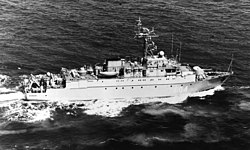Project 12660
|
Project 12660 Schelesnjakow 1989
|
||||||||||||||
|
||||||||||||||
|
||||||||||||||
|
||||||||||||||
|
||||||||||||||
Project 12660 Code name: Rubin ( Russian Рубин , NATO designation: Gorya class) is a class of ocean-going mine clearance vessels of the Soviet and later the Russian navy . The two ships of the class were developed by the Soviet Union as deep-sea mine sweepers.
description
Project 12660 was designed to discover and clear sea mines at great depths. To this end, the mine sweeper technology of Project 266M has been supplemented by more advanced, remote-controlled search robots that can be launched via the 406 mm torpedo tubes . These anti-mine drones were equipped with a modern Kabarga-AZ sonar (named after the Siberian musk deer ), which sends target information directly to the drones. In addition, a Gjurza (" Levante otter ") sonar is installed. To destroy mines, an explosive charge can also be released from a cable up to 2,200 meters long.
The machinery from Project 266M was retained, but a bow thruster was added.
The arrangement and composition of the armament was changed and only a 30 mm L / 63 AK-630 anti-aircraft tower was placed on the roof of the superstructure aft. The standard gun turret for combating surface targets, which was installed on numerous contemporary frigates and corvettes of the Soviet Union, the 76-mm-L / 60- AK-176M, was positioned at the bow.
Whereabouts
Twelve ships were planned in 1985 and 1986. It turned out, however, that ships of this size were not being built at the Nevsky Shipyard under the deadline. The class was given up after only two ships had been built and a new building that had been started was abandoned.
literature
- Ю.В.Апальков: Корабли ВМФ СССР. Том IV - Десантные и минно-тральные корабли. Saint Petersburg, 2007, ISBN 978-5-8172-0135-2 . (Russian)
Web links
- Project 12660 at russianships.info (English)
Individual evidence
- ↑ a b c Ю.В.Апальков: Корабли ВМФ СССР. Том IV - Десантные и минно-тральные корабли. Saint Petersburg, 2007, ISBN 978-5-8172-0135-2 , p. 99 and following
